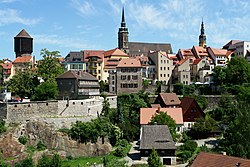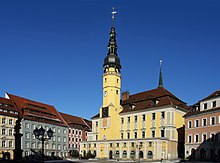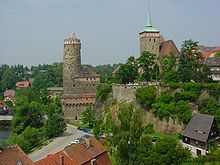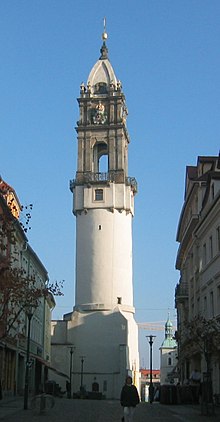Bautzen: Difference between revisions
→International relations: clean up and general fixes using AWB |
m region disbanded using AWB |
||
| Line 6: | Line 6: | ||
|Wappen = Wappen Bautzen.png |
|Wappen = Wappen Bautzen.png |
||
|Bundesland = Sachsen |
|Bundesland = Sachsen |
||
|Regierungsbezirk = Dresden |
|||
|Landkreis = Bautzen |
|Landkreis = Bautzen |
||
|lat_deg = 51 | lat_min = 10 | lat_sec = 53 |
|lat_deg = 51 | lat_min = 10 | lat_sec = 53 |
||
Revision as of 18:07, 3 July 2013
Bautzen | |
|---|---|
 | |
Location of Bautzen within Bautzen district  | |
| Country | Germany |
| State | Saxony |
| District | Bautzen |
| Subdivisions | 15 |
| Government | |
| • Mayor | Christian Schramm (CDU) |
| Area | |
| • Total | 66.62 km2 (25.72 sq mi) |
| Elevation | 204 m (669 ft) |
| Population (2022-12-31)[1] | |
| • Total | 38,140 |
| • Density | 570/km2 (1,500/sq mi) |
| Time zone | UTC+01:00 (CET) |
| • Summer (DST) | UTC+02:00 (CEST) |
| Postal codes | 02625 |
| Dialling codes | 03591 |
| Vehicle registration | BZ |
| Website | www.bautzen.de |
Bautzen (German pronunciation: [ˈbaʊtsən] ; Upper Sorbian: Budyšin [ˈbudɨʃin] ; Lower Sorbian: Budyšyn [ˈbudɨʃɨn], Czech: Budyšín, Polish: Budziszyn) is a hill-top town in eastern Saxony, Germany, and administrative centre of the eponymous district. It is located on the Spree River. As of 2008, its population is 41,161. Asteroid 11580 Bautzen is named in honor of the city.
Bautzen is often regarded as the unofficial, but historical capital of Upper Lusatia, and it is the most important cultural centre of the Sorbs, a Slavic people.
Geography
Geographical situation
The town on the River Spree is situated about 50 kilometres east of Dresden between the Lusatian highland and the lowlands in the north, amidst the region of Upper Lusatia. To the north stretches the Bautzen Reservoir, which was flooded in 1974. This is the former location of the villages of Malsitz (Małšecy) and Nimschütz (Hněwsecy).
Expansion of the urban area
The old part of Bautzen is located on the plateau above the Spree, whose top is marked by the Ortenburg castle. It is bordered by the city walls. The later-built more recent quarters in the east were enclosed by the city ramparts. After their removal, the city expanded further east and to the left bank of the river. However, there has only been a small urban area west of the Spree until today. In the 1970s, the development areas of "Gesundbrunnen" and "Allendeviertel" were erected. After 1990, several neighbouring villages were incorporated.
Bordering municipalities
The city is bordered by Radibor, Großdubrau and Malschwitz in the North, Kubschütz in the East, Großpostwitz, Obergurig and Doberschau-Gaußig in the South, as well as Göda in the West. All of these belong to the Bautzen district.

Subdivisions
The 15 city districts are (inhabitants as of January 1, 2009):
- Innenstadt (Nutřkowne město - "City centre"), 5'278 inh.
- Südvorstadt (Južne Předměsto - "Southern outskirts"), 1'738 inh.
- Westvorstadt (Zapadne Předměsto - "Western outskirts"), 3'505 inh.
- Gesundbrunnen (Strowotna studnja), 8'178 inh.
- Nordostring (Sewjerowuchodny Wobkruh - "North-eastern ring"), 10'727 inh.
- Ostvorstadt (Wuchodne Předměsto - "Eastern outskirts"), 6'360 inh.
- Teichnitz (Wuchodne Předměsto), 377 inh.
- Nadelwitz (Nadźankecy), 268 inh.
- Burk (Bórk), 325 inh.
- Oberkaina (Hornja Kina), 832 inh.
- Niederkaina (Delnja Kina), 522 inh.
- Stiebitz (Sćijecy), 510 inh.
- Kleinwelka (Mały Wjelkow), 1'314 inh.
- Salzenforst-Bolbritz (Słona Boršć-Bolborcy), 839 inh.
- Auritz (Wuricy), 458 inh.


History
In the 3rd century AD an eastern Germanic settlement existed here, but excavations have proved that the region was already inhabited as early as the late Stone Age.
The first written evidence of the existence of the city was in 1002. In 1018 the Peace of Bautzen was signed between the German king Henry II and the Polish prince Boleslaus I. The Treaty left Bautzen (Budziszyn in modern Polish) under Polish rule. In 1033 the city passed to the Holy Roman Empire, in 1319 to Bohemia and in 1635 to Saxony. During the Middle Ages it was a member of the Six Cities' Alliance of the Upper Lusatian cities of Görlitz, Zittau, Löbau, Kamenz, Lauban and Bautzen.
It was the site of one of the battlefields of the Napoleonic War Battle of Bautzen in 1813.
During World War II and the Nazi era, there was a subcamp of the Groß-Rosen concentration camp in Bautzen. Ernst Thälmann was imprisoned there before being deported to Buchenwald. Between 21 April and 30 April 1945, the Battle of Bautzen was fought.
Furthermore Bautzen was infamous throughout the German Democratic Republic for its penitentiaries. Bautzen I was used as an official prison, soon to be nicknamed Gelbes Elend ("Yellow Misery"), whereas the secret Bautzen II was used as a prison for prisoners of conscience. Bautzen I is still used as a prison, and Bautzen II has served as a memorial since 1993.
In 2002 the city commemorated its thousandth birthday.
International relations
Bautzen is twinned with:

 Worms, since 1990
Worms, since 1990 Heidelberg, since 1991
Heidelberg, since 1991 Dreux, France, since 1992
Dreux, France, since 1992 Jablonec nad Nisou, Czech Republic, since 1993
Jablonec nad Nisou, Czech Republic, since 1993 Jelenia Góra, Poland, since 1993
Jelenia Góra, Poland, since 1993
Main sights
Bautzen has a very compact and well preserved medieval town centre with numerous churches and towers and a city wall on the steep embankment to the river Spree, with one of the oldest preserved waterworks in central Europe (built 1558).
Sites of interest include:
- The Reichenturm, one of the steepest leaning and still passable towers north of the Alps
- Ortenburg Castle
- The Old Waterworks, an architectural monument and museum
- Saint Peter's Cathedral, Eastern Germany's only historic interdenominational church edifice
- Hexenhaus (Witch's House), oldest preserved residential building (built in 1604)
There are four museums including the Stadtmuseum Bautzen ("Bautzen city Museum") and the Sorbisches Museum ("Sorbian Museum", Sorbian: Serbski muzej).
People
References
- ^ "Einwohnerzahlen nach Gemeinden als Excel-Arbeitsmappe" (XLS) (in German). Statistisches Landesamt des Freistaates Sachsen. 2024.
External links
- Official website (in English)
- Interactive sightseeing tour through Bautzen
- City and regional portal of Bautzen and the Oberlausitz
- Gilman, D. C.; Peck, H. T.; Colby, F. M., eds. (1905). New International Encyclopedia (1st ed.). New York: Dodd, Mead.
{{cite encyclopedia}}: Missing or empty|title=(help) - . Encyclopedia Americana. 1920.


